Milkomeda
Author: Frank Chukwurah
Date: 14/10/2023
Milkomeda: EVM Compatibility for Cardano and Algorand
INTRODUCTION
Have you heard about Milkomeda? If you’ve not heard it about, don’t fret! I'm about to plug you into a game-changer. Milkomeda exists to be a groundbreaking protocol designed with the intent to power several leading blockchain's in the industry such as Algorand, Terra, Solana, and the likes of Cardano. This build will exponentially level-up and create a path for long-term scaling.
For the sake of clarity, Milkomeda fosters interoperability; enabling applications to work swiftly in multiple chains. Imagine that your favorite Android app could also work on your iPhone without any changes!
In this article, we will embark on an explorative journey, discussing what Milkomeda is and how it's contributing to the blossoming work of blockchain technology.
How Does Milkomeda Work?
Milkomeda, a layer2 protocol pioneering both Cardano and Algorand. It’s dedicated to offering Ethereum Virtual Machine (EVM) compatibility. More so, we have a Milkomeda A1 (Algorand) and C1 (Cardano), these are the two of the most popular products that keeps the platform up and running whilst enabling individuals to interact with a wide variety of assets and blockchain's as well.
OVERVIEW OF MILKOMEDA A1
Milkomeda A1 is one of the promising EVM Rollup owing its existence to Algorand blockchain as a Layer2 solution. For greater benefits, Milkomeda a1 provides rapid and low-cost transactions, making it a center of attraction for DeFi applications and platforms. Milkomeda A1, at its core, seeks to empower developers by enabling them to leverage the full potential of the EVM ecosystem plus, Solidity smart contracts, ERC-20 tokens, and other DeFi protocols contributing to the public good.
The sole purpose of Milkomeda A1 is to provide faster and cheaper transactions on the Algorand network. We’ve all been there! Everyone is talking about Ethereum gas fees - I’ve been holding $15 worth of USDC in my Etherum wallet for 5 months now! I’d probably need around $20 worth of ETH for gas - This is where Algorand comes in, users can seamlessly transact with Ethereum-based assets and smart contracts in a permissionless and trustless manner whilst reducing gas fees and increasing yield.
OVERVIEW OF MILKOMEDA C1
On the other hand, we have Milkomeda C1. It is a layer 2 EVM Rollup solution for Cardano blockchain. The execution of this Rollup will allow Cardano to access the benefits of EVM, making the creation and execution of smart contracts with ease as you would on Ethereum.
Security is at the forefront of Milkomeda C1, it achieves this through a combination of technique known as a zkSNARK-based proof system. Just like Zcash - a digital currency that keeps transaction information private, Milkomeda C1 is no different - Zero-Knowledge helps to ensure that all transactions handled by Milkomeda C1 are valid and free of malicious activity. Furthermore, Milkomeda C1 smart contracts allow users to deposit funds with ease, and execute transactions in a trustless and decentralized manner.
Milkomeda Token
At the moment, Milkomeda have not launched its own native token yet! However, the protocol leverages wrapped tokens from other popular blockchain networks to enable transactions.
There are currently two major wrapped tokens that are used on Milkomeda, they are:
MilkADA
MilkAlgo
MilkADA is a wrapped token that was coined from ADA - Cardano's native cryptocurrency. MilkADA will function as a settlement currency for transactions on the Milkomeda C1 EVM Rollup. Users can swiftly create the MilkADA wrapped token by depositing ADA into a smart contract on the Cardano blockchain.
Following that, MilkAlgo is a wrapped token that was coined from ALGO - of Algorand's native cryptocurrency, it would serve as a mean of Exchange and settlement of transactions on the milkomeda A1 ecosystem.
Features of Milkomeda
Scalability is very pivotal and it makes Milkomeda to be able to scale hundreds of transactions per second without sacrificing long-term decentralization.
In the paragraph above, we discussed the importance of zkSNARK. It handles the security and privacy side of things; Milkomeda aims to leverage the power of Rollups for all chains, it has also been audited by two of the biggest blockchain security technology companies - Certik and Certora, to ensure security of the protocol.
Here at Milkomeda, we prioritize user experience like our life depends on it, Milkomeda has joined forces with several wallets to ensure the movement of assets to Milkomeda is straightforward.
Interoperability is crucial to the mainstream blockchain adoption; Milkomeda will support Solidity (EVM) and much more.
Milkomeda ensures portability; developers only to to write their code only once and they can deploy everywhere conveniently. All of the tooling and resources of Ethereum are open to all developers.
How Does Milkomeda Bridge Work?
One of the key components of the Milkomeda protocol is the Milkomeda Bridge, it fosters cross-chain asset using a set of smart contracts that monitors, verifies the movement or transfers of assets between blockchain's that are connected. The Milkomeda Bridge works by creating a temporary wallet on the target chain when an individual initiates a transfer of digital asset from one blockchain to another.
How it works technically on the Cardano C1 Rollup.
In light of the Milkomeda C1 sidechain, it uses MilkADA as the base asest for incentivizes and gas,to get started, you should get a Cardano wallet with some ADA as well as the MetaMask browser extension.
Getting a Cardano Wallet (Flint)
Firstly, install the Flint wallet. The latest version of Flint wallet enables "Milkomeda mode" to initiate transactions to the Milkomeda C1 sidechain.
After you've successfully installed Flint, click "Lets Begin", choose your preferred language, agree to the terms and conditions. Once you land on the Network screen, select the Mainnet button. Confirm, follow the prompt and "Create New Wallet." Once that is done, you,ll need to fund your wallet with some ADA, next we need to configure MetaMask.
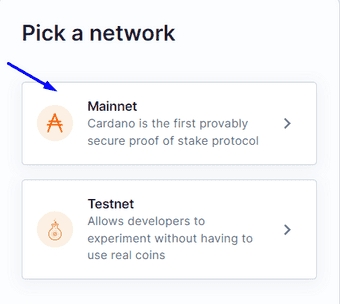
Setting up Milkomeda wallet (MetaMask)
Moving forward, we need to get a wallet address on the Milkomeda C1 sidechain for receiving our MilkADA, we'll use MetaMask for this step.
Install the MetaMask Chrome Extension and create a wallet address if you do not have one. Always keep your private key safe. Select the network drop down at the top right, then select "Add Network," and enter the following.

Once that is down, click "Save", by now you should see "Milkomeda Cardano C1" in the network drop down. Copy your C1 wallet address as we'll be needing it soon!
Wrapping Assets on Milkomeda C1
Launch your Flint wallet and navigate to the "Send" window. Toggle "Milkomeda mode", paste the C1 wallet address you copied a few minutes ago, enter the amount you wish to send and click ""Continue."
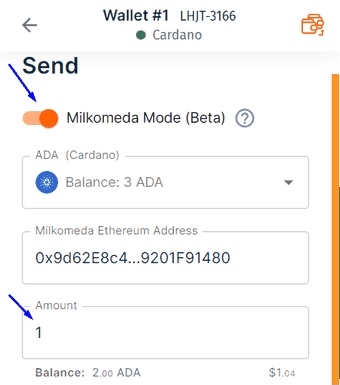
Enter your password and hit "Send". The takes around 5 minutes, once the transaction is confirmed, MilkADA will be visible in your C1 wallet in MetaMask.
How it works technically on Algorand A1 Rollup.
The Milkomeda A1 Rollups leverages MilkALGO as a base asesst for transaction fees and gas - to access this Rollup, users need a Algorand native wallet holding some $ALGO token, and MetaMask wallet as well.
Configure Wallet & Obtain Test Algo
In other to interact with the Milkomeda Algorand Bridge, you should configure an Algorand wallet such as MyAlgo. Once you've successfully created your new wallet, you need to obtain Test ALGO. This will enable you to interact with the Bridge dApp. Visit the Test ALGO Explorer, paste your new created wallet address and click Dispense; you should be able to see some tALGO in your Algorand Testnet wallet.

Configure MetaMask
Install MetaMask, once its up and running, Add Network from the dropdown list and enter the following and save:

Wrapping Assets With Milkomeda Bridge
To transfer assets from the Algorand mainchain to Milkomeda A1 Rollup, you will use the desicated bridge - If you want to wrap your asset onto the A1 Rollup,goto the Milkomeda A1 Bridge navigate.
To start wrapping your assets, Select Algorand to Milkomeda from the "Network Origin" menu then choose the token you want to wrap. For example, ALGO.
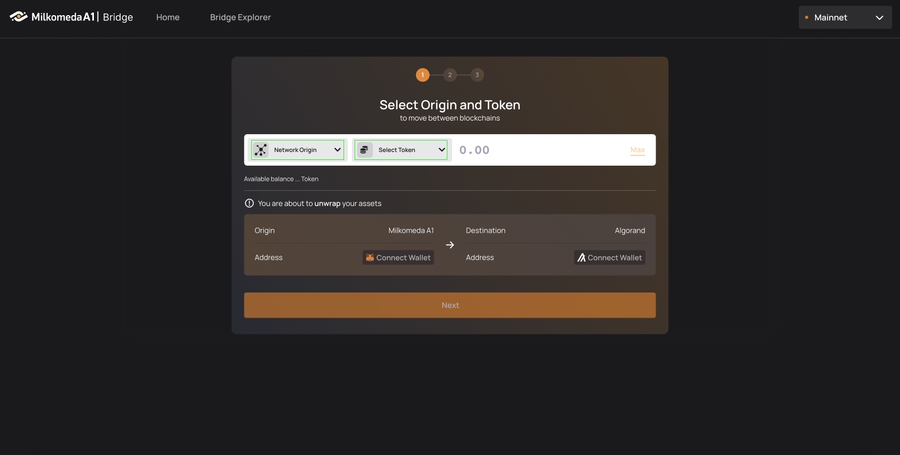
Next, connect MyAlgo wallet with MetaMask. Click connect on the Origin side and your MyAlgo wallet will require your password, confirm which account you'll connect to the dApp. On the Destination side, click connect wallet, confirm which network you're switching to (if you're not already connected to it to the Milkomeda A1 network).
Input how many test ALGOs you want to transfer to the A1 Rollup. Following that, click "Next" to view the trasaction summaty - it includes "Estimated Fees" and "Estimated Wrapping Confirmation Time."
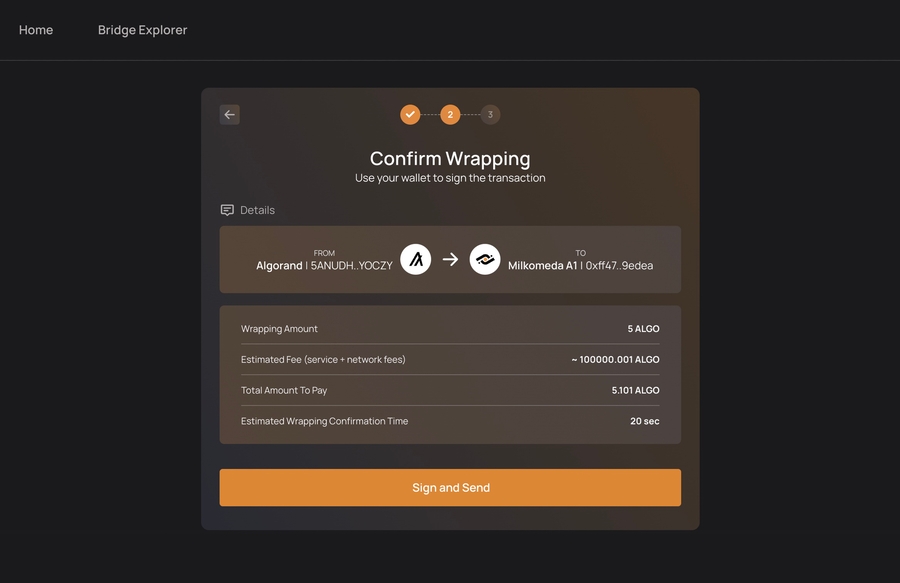
Hit "Sign and Send" confirm; you token will be sent to the bridge, wrapped, and also sent received by your MetaMask wallet on the Milkomeda Algorand A1 Rollup! It takes around 20 seconds to comfirm.
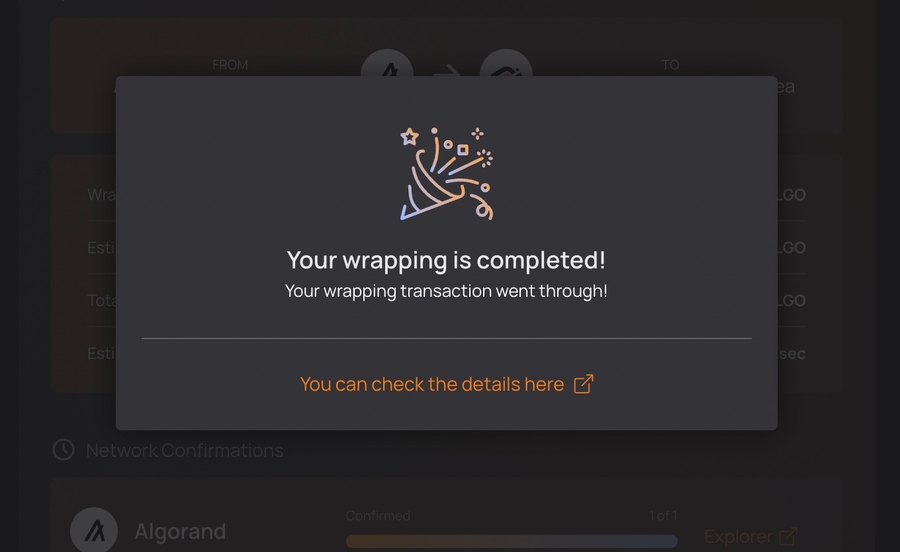
After the transfer is done, the Bridge submits a request to the target chain's smart contract for minting a wrapped version of the asset. Once the transaction is verified and confirmed, these wrapped asset (MilkAlgo) can be freely transferred and utilized on the target chain.
How to use Milkomeda?
Interoperability has been a pressing challenge for blockchain industries having known that different blockchain's have their own peculiar characteristics, such as consensus algorithms, smart contract languages, and network infrastructures. Milkomeda rose to prominence as a cutting-edge technology protocol that allows interoperability between blockchain's by providing an EVM-compatible layer 2 which will enable non-EVM blockchain's to access EVM capabilities.
Any individual looking to explore and witness how Milkomeda solves the problem of interoperability would need to determine the blockchain network he wants to connect to Milkomeda for getting started. Say you’re looking to connect Cardano to Milkomeda, you need Milkomeda C1, and if its Algorand you want to connect to Milkomeda, you’ll need Milkomeda A1. Once you’ve selected the Milkomeda Rollup that suit your needs, simply create a wallet address on the blockchain network you selected.
My Opinion on Security and Convenience!
Lets cut to the chase, since the Milkomeda protocol is based on zkSNARKS, privacy and security cannot be compromised; it is also audited by two of the industry-leading blockchain autitors - Certik and Certora. Our token completely save from negative expliots, no loopholes and it's also very fast while carrying out transactions.
Closing Thoughts:
It is worth mentioning that users could create and deploy smart contracts easily on the EVM Rollup. Whatever your needs are, you can take full control of the Ethereum Virtual Machine. Users can create and deploy their own decentralized applications without worrying about the ETH gas fees or scalability limitations encountered by users while leveraging the Ethereum mainnet.
Lastly, stablecoins such as DJED usually play an essential role in the decentralized finance ecosystem because they offer a means of exchange without the volatility of cryptocurrencies. In that same light, the Milkomeda A1 and C1 EVM Rollups connects to the Algorand and Cardano blockchain's as layer 2s, individually, they will provide an excellent platform for stablecoin development and solve the problem of interoperability in the blockchain industry.
Additional Links
Twitter Profile:
Last updated